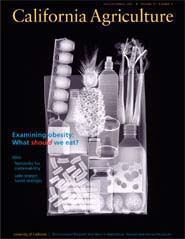All Issues

Examining obesity: What should we eat?
Cover:
As obesity rates climb, studies surge as well---sometimes resulting in contradictory claims about nutrition, weightloss and even ideal weight. In this special collection, our authors review a large body of scientific literature on obesity prevention, present new research findings and offer case studies of community interventions.
July-September 2007
Volume 61, Number 3
Volume 61, Number 3
News and opinion
General Information
ANNOUNCEMENT
To our readers





